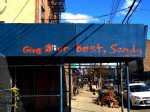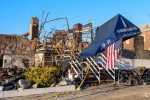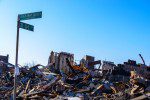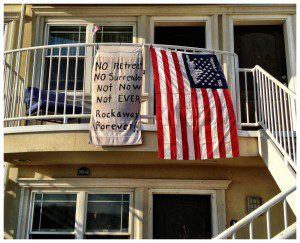
11 Dec JUST BEFORE BIG BENEFIT CONCERT, A SANDY SURVIVOR LOOKS BACK
Editor’s Note: Of course there’s a Telluride connection. Some of the biggest names in music will play at a benefit concert on Wednesday at Madison Square Garden. The Stones join a trio of 1960s British rock royalty on the bill, including Paul McCartney and the Who. Among the other artists scheduled to appear are Bruce Springsteen & The E Street Band, Alicia Keys, Kanye West, Eric Clapton, Eddie Vedder, Billy Joel, Roger Waters and Chris Martin. All proceeds will go to Hurricane Sandy victims, via the Robin Hood Foundation – and part-time Telluride local Mark Dalton sits on that board. (Show time is 7:30 p.m. EST.)
David Barlow is also a part-time local. He submitted this lyrical essay about Horror-cane Sandy to remind us all why those who can should support those in need. Sandy is history, but all too many of still living with the devastation she left in her wake.
When the lights went out at 9:20 p.m. on Tuesday, October 30th, I was at my computer. I figured the electricity would be restored by morning. I had no idea that a giant green fireball had ignited the sky above Con Edison’s 14th St. power plant, and that everywhere below 39th St. would remain dark for nearly six days.
I live on 35th St. and Third Avenue, so it was an easy shot for me to walk into the light and ordinary hum of Midtown Manhattan. But I spent the first two days post “Super Storm” Sandy holed up at home with no cell service or internet, eating all my perishable food. Then on the third night, I walked three miles to my friend Arthur’s place on the Upper East Side to make some calls, check email, and watch the news. It was Halloween and as revelers passed me in ghoulish costumes, I pictured people half an island away worrying about the very real specters of looters trying to break into buildings and stores. They were quietly cooped in dark apartments, bundled up, eating out of cans if they didn’t have gas stoves to heat their food.
 Arthur took me to a Mexican joint on 80th and Lex, where we got a corner spot with a good view of everyone out on the town. I caught the eye of a woman in a black cloak, her face painted like a skull, and instantly I thought of the two little boys I’d just seen on CNN. They’d been ripped from their mother’s arms by the sea after her SUV stalled in Staten Island. Their bodies were found 100 yards apart from each other at the end of a dead-end street. To our left, a table of four “Pharoahs” ate, wearing golden cloaks and headpieces, leaving me half wondering if their costumes were ironic allusions to the biblical flood some historians say drowned much of ancient Egypt.
Arthur took me to a Mexican joint on 80th and Lex, where we got a corner spot with a good view of everyone out on the town. I caught the eye of a woman in a black cloak, her face painted like a skull, and instantly I thought of the two little boys I’d just seen on CNN. They’d been ripped from their mother’s arms by the sea after her SUV stalled in Staten Island. Their bodies were found 100 yards apart from each other at the end of a dead-end street. To our left, a table of four “Pharoahs” ate, wearing golden cloaks and headpieces, leaving me half wondering if their costumes were ironic allusions to the biblical flood some historians say drowned much of ancient Egypt.
By midnight, I’d crossed back over the border that separated the flashing lights and packed bars of “civilization” from the no man’s land of lower Manhattan. Except for the recurring wail of emergency vehicles, our side of the city had the same hush as after a blizzard.
 With the return of daylight, I scrounged my bike out of storage, filled the tires, oiled the chain, and headed first for the East River. The water had come in hard and fast, turning the deep pit of a construction site on 35th St. into a square block lake. Trees all along Stuyvesant Town were down, and the water line measured high up the concrete partition on the opposite side of the FDR Drive. Water was still being pumped out of basements and parking garages. Debris was everywhere, and some industrious citizens were out cleaning up the park by the Williamsburg Bridge. I turned into Alphabet City and Chinatown, and right away noticed how eerie things felt the further I rode south. I imagined how frayed people’s nerves must be climbing flights of dark stairs in the public housing projects – food spoiling in warm fridges, no water to flush festering toilets. Every few blocks they were huddled about generators to recharge their electronic devices, and a long line had formed along Grand Street to pick up rations supplied by the National Guard.
With the return of daylight, I scrounged my bike out of storage, filled the tires, oiled the chain, and headed first for the East River. The water had come in hard and fast, turning the deep pit of a construction site on 35th St. into a square block lake. Trees all along Stuyvesant Town were down, and the water line measured high up the concrete partition on the opposite side of the FDR Drive. Water was still being pumped out of basements and parking garages. Debris was everywhere, and some industrious citizens were out cleaning up the park by the Williamsburg Bridge. I turned into Alphabet City and Chinatown, and right away noticed how eerie things felt the further I rode south. I imagined how frayed people’s nerves must be climbing flights of dark stairs in the public housing projects – food spoiling in warm fridges, no water to flush festering toilets. Every few blocks they were huddled about generators to recharge their electronic devices, and a long line had formed along Grand Street to pick up rations supplied by the National Guard.
 I rode past City Hall and onto the Brooklyn Bridge where thousands of people were crossing in both directions. Once in Brooklyn, I pushed on to my sister’s place in Park Slope, making it in time for dinner and a TV movie. In no time the blacked out city across the river had begun to seem like a far away land. But of course even in the stretches of Brooklyn that had been spared from flooding and power outage, tragedy had still struck. My nephew Henry’s roommate is the brother of a young woman who was killed with her childhood friend in Ditmas Park when an uprooted tree fell on them. They had gone out to walk her dog, which was also hit, but survived, staying with the bodies until they were discovered in the morning.
I rode past City Hall and onto the Brooklyn Bridge where thousands of people were crossing in both directions. Once in Brooklyn, I pushed on to my sister’s place in Park Slope, making it in time for dinner and a TV movie. In no time the blacked out city across the river had begun to seem like a far away land. But of course even in the stretches of Brooklyn that had been spared from flooding and power outage, tragedy had still struck. My nephew Henry’s roommate is the brother of a young woman who was killed with her childhood friend in Ditmas Park when an uprooted tree fell on them. They had gone out to walk her dog, which was also hit, but survived, staying with the bodies until they were discovered in the morning.
 Up until this point, I had seen nothing of the real devastation wrought by Sandy. Then I got a call from a man whose son’s home was destroyed by the waves that raced across the Rockaways. He asked me and twenty other men to come dig out his son’s basement, hammer down the sheetrock, rip out the floors, and pitch everything—furniture, sinks, toilets, plaster, floorboards—out into a massive mile long mound of debris that lined Ocean Promenade. I spent half the day in the basement with five other guys sending up bucket after bucket of sand and sludge. It was shocking to see up close: what had been the family TV den was now a dank blackened cesspool of crap; and the sheer tonnage of beach that the ocean had deposited into this man’s home was remarkable. It took several hours to excavate the staircase alone, which had been entirely buried. And this was only one home among thousands that were just as ruined, or worse… The sheer force of nature, the speed at which that much earth is reconfigured by a hurricane in a single day, in minutes, has to give one—or it gave me anyway—a sense of how the ice and glacial deposits of 10,000 years ago formed the very barrier island we were now on, and of just how swiftly it could all be reclaimed by a rising sea.
Up until this point, I had seen nothing of the real devastation wrought by Sandy. Then I got a call from a man whose son’s home was destroyed by the waves that raced across the Rockaways. He asked me and twenty other men to come dig out his son’s basement, hammer down the sheetrock, rip out the floors, and pitch everything—furniture, sinks, toilets, plaster, floorboards—out into a massive mile long mound of debris that lined Ocean Promenade. I spent half the day in the basement with five other guys sending up bucket after bucket of sand and sludge. It was shocking to see up close: what had been the family TV den was now a dank blackened cesspool of crap; and the sheer tonnage of beach that the ocean had deposited into this man’s home was remarkable. It took several hours to excavate the staircase alone, which had been entirely buried. And this was only one home among thousands that were just as ruined, or worse… The sheer force of nature, the speed at which that much earth is reconfigured by a hurricane in a single day, in minutes, has to give one—or it gave me anyway—a sense of how the ice and glacial deposits of 10,000 years ago formed the very barrier island we were now on, and of just how swiftly it could all be reclaimed by a rising sea.
Two doors down from the house where we were working, I noticed that someone had draped a large American flag over the railing of a deck. Next to the flag hung a white towel spray-painted in black letters that read:
 NO Retreat
NO Retreat
NO Surrender
NOT NOW
NOT EVER
Rockaway Forever!!
Such is the persistence of a sense of place.
I can’t say I’ve ever truly loved my neighborhood of Murray Hill, but now I appreciate that I do indeed live on a hill. One day when the East River is lapping up along the shores of Second Avenue, my building will have an interesting view of boaters meandering around the corners of buildings that rise out of the water. The UN might be such a building. Of course, if that happens to our city, it’ll be long after I’m gone.
Or will it…
Note: All photos by David Barlow and Ben Lazar



Sorry, the comment form is closed at this time.